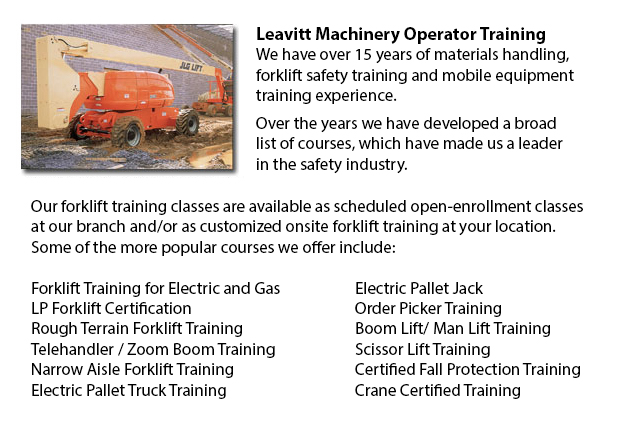
Boom Lift Safey Training Saskatchewan - Boom lifts are a type of elevated work platform or aerial lifting device that are usually used in construction, industry, and warehousing. Boom lifts could be made use of in virtually whatever setting because of their versatility.
The elevated work platform is utilized to be able to allow access to heights which were otherwise inaccessible using other methods. There are risks inherent when making use of a boom lift device. Employees who operate them must be trained in the right operating techniques. Accident prevention is vital.
Boom Lift Training Programs include the safety aspects involved in boom lift operation. The program is best for those who operate self-propelled boom supported elevated work platforms and self-propelled elevated work platforms. Upon successful completion of the course, People who participated would be given a certificate by somebody authorized to confirm completing a hands-on evaluation.
So as to help train operators in the safe utilization of elevated work platforms, industry agencies, federal and local regulators, and lift manufacturers all play a role in providing the necessary information and establishing standards. The most essential ways in avoiding accidents connected to the use of elevated work platforms are the following: having on safety gear, performing site assessment and checking equipment.
Key safety factors when operating Boom lifts:
Operators stay away from power line, observing the minimum safe approach distance (or also known as MSAD). Voltage can arc across the air to find an easy path to ground.
So as to maintain stability when the platform nears the ground, a telescopic boom should be retracted prior to lowering a work platform.
Boom lift workers should tie off to guarantee their safety. The harness and lanyard contraption should be connected to manufacturer provided anchorage, and never to other poles or wires. Tying off may or may not be required in scissor lifts, that depends on specific job risks, local rules, or employer guidelines.
The maximum slope would be specified by the manufacturer. Workers must avoid working on a slope, if possible. When the slope exceeds recommended conditions, the lifting device must be winched or transported over the slope. A grade can be measured with no trouble by laying a straight edge or board of at least 3 feet on the slope. Afterward a carpenter's level can be laid on the straight edge and raising the end until it is level. The percent slope is obtained by measuring the distance to the ground (also known as the rise) and then dividing the rise by the length of the straight edge. Next multiply by one hundred.
-
Forklift Ticket Saskatchewan
Forklift Ticket Saskatchewan - Pallet jacks and forklifts are both meant for basically the same purpose; to move supplies from one location of your warehouse to another. This is pretty much where the comparison stops however. With the pallet jack, th... More -
Loader Ticket Saskatchewan
Loader Ticket Saskatchewan - Gehl articulated loaders have been made to suit practically any condition. They provide great traction and optimal maneuverability due to a heavy-duty oscillating joint that offers forty five degree rotating angles left a... More -
Forklift Training Programs Saskatchewan
Forklift Training Programs Saskatchewan - Are you searching for work as a forklift driver? Our regulatory-compliant mobile equipment operator training provides instruction in kinds of forklifts, pre-shift check, fuel kinds and handling of fuels, and... More -
Heavy Equipment Operator Classes Saskatchewan
Heavy Equipment Operator Classes Saskatchewan - A heavy equipment operator is an individual who has received the right training in order to operate a particular kind or piece of machinery. There are lots of ways for the operator to undergo training a... More -
Telehandler Training in Saskatchewan
Telescopic handlers usually known as telehandlers for short, are an extremely popular piece of heavy construction equipment. They are usually utilized in the construction and agricultural trades. These equipments have farthest reaching capacity and a... More -
Narrow Aisle Forklift / Order Picker Training / Electric Pallet Jack / Electric Pallet Truck Training in Saskatchewan
A pallet lift is a piece of equipment dedicated in the transporting of pallets of various dimensions and weights. They can be utilized as an attachment for forklifts, cranes and other types of heavy machinery or be applied on their own. Pallet lifts... More -
Operator Safety Training, Re-Qualification Training, In-House Instructor Training in Saskatchewan
Used in just about all industrial construction sites, warehouse operations or boat yards, the lift truck is a very important component so as to help pick up and transfer supplies. The reach feature of a forklift can help improve the applications whic... More -
Aerial Lift Ticket Saskatchewan
Aerial Lift Ticket Saskatchewan - Boom vehicle are often used by phone, cable and utilities firms as they have extended folded arms which are generally folded over the roofs of business vehicles. On the end of the extension of extendable arms usually... More

Forklift Training Saskatchewan
TOLL FREE: 1-888-254-6157
Saskatoon, Saskatchewan
forklifttrainingsaskatchewan.com
Email Us
About Us



